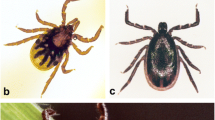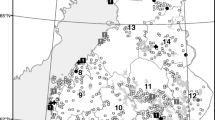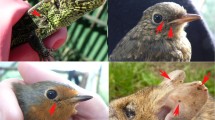Abstract
A survey for tick-borne encephalitis virus in Ixodes ricinus ticks was conducted in May 2000 in two districts of the South-Bohemian region of the Czech Republic with a high occurrence of tick-borne encephalitis (TBE) in humans. Homogenized ticks were tested on PS cells, which were examined for any cytopathic effect, plaque assay and indirect fluorescent antibody test (IFT). The IFT has proved to be the most sensitive and most rapid test to demonstrate the virus in ticks. TBE virus was found in 17 of 187 pooled samples, consisting of a total of 2,968 ticks. The mean minimum infection rate was 0.6% for all tick stages combined. Infection rates in nymphs collected indifferent locations varied between 0.2 and 1.3% and between 5.9 and 11.1% in adult ticks. The observed TBE prevalence in ticks was compared with data obtained elsewhere in the Czech Republic. It is concluded that screening of ticks for TBE virus prevalence using IFT is a valuable indicator for the degree of risk to contract TBE in as particular habitat.
Similar content being viewed by others
References
Anonymous 2001. Notification of Infectious Diseases. Czech Republic (EPIDAT) Hygienic Service, National Reference Centre for Analysis of Epidemiological Data, National Institute of Public Health, Prague.
Daniel M., Kolá? J., Zeman P., Pavelka K. and Sádlo J. 1998. Prediction map of Ixodes ricinus highincidence habitats and tick-borne encephalitis risk assessment using satellite data. Exp. Appl. Acarol. 22: 417-433.
Daniel M., Kolá? J. and Beneš C. 2000. Predictive maps of Ixodes ricinus high incidence habitats and tick-borne encephalitis risk assessment based on remote sensing data. Remedia-Clinical Microbiology 4: 252-257.
Danielová V., Daniel M., Holubová J., Hájková J., Albrecht V., Marhoul Z. et al. 1983. Influence of microclimatic factors on the development and virus infection rate of ticks Ixodes ricinus (L.) under experimental conditions. Folia Parasit. 30: 153-161.
Danielová V. and Málková D. 1980. Tick-borne arboviruses in recreation areas. In: Labuda M. and Calisher C.H. (eds), New Aspects in Ecology of Arboviruses, Proceedings International Symposium. Institute Virology, Slovak Academy of Sciences, Bratislava, pp. 445-449.
Januška J. 2000. Results of virological investigations of ticks from the Czech Republic tested in the National Reference Laboratory for Arboviruses in 1970-1999 (in press).
Süss J., Schrader Ch., Abel U., Voigt W.P. and Schosser R. 1999. Annual and seasonal variation of tickborne encephalitis virus (TBEV) prevalence in ticks in selected hot spot areas in Germany using a nested RT-PCR: Results from 1997 and 1998. Zent. bl. Bacteriol. 289: 564-578.
Author information
Authors and Affiliations
Rights and permissions
About this article
Cite this article
Danielová, V., Holubová, J. & Daniel, M. Tick-borne encephalitis virus prevalence in Ixodes ricinus ticks collected in high risk habitats of the South-Bohemian region of the Czech Republic. Exp Appl Acarol 26, 145–151 (2002). https://doi.org/10.1023/A:1020966605960
Issue Date:
DOI: https://doi.org/10.1023/A:1020966605960




